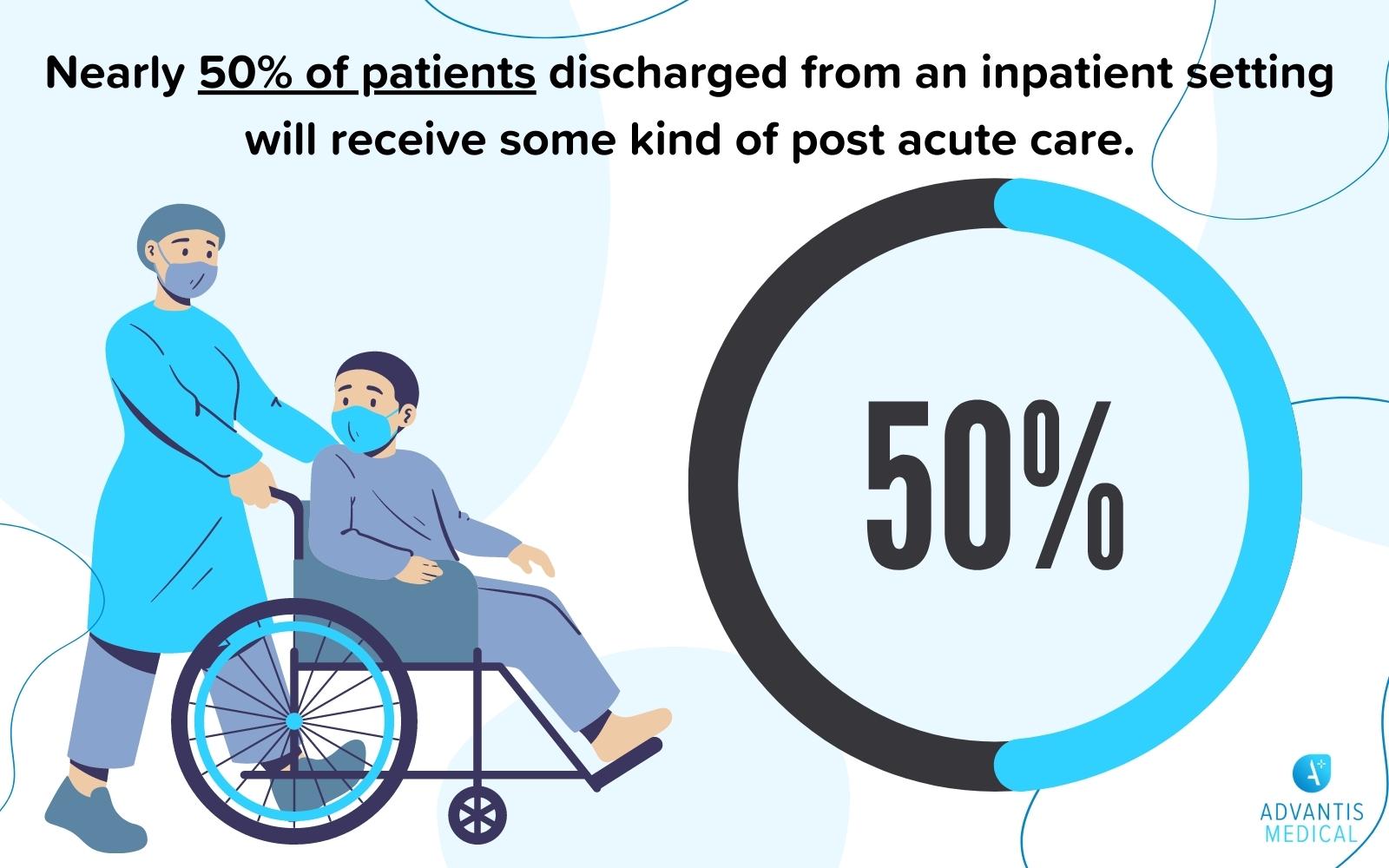Fear. Confusion. Uncertainty. That’s often what follows a hospital discharge. The relief of surviving a health crisis quickly turns into a daunting question: What happens next?
The truth is, recovery doesn’t always end when you leave the hospital. It continues with post-acute care, a vital yet often misunderstood part of the healing journey.
If you find yourself transitioning to post-acute care, you’re not alone. Nearly 50% of patients discharged from an inpatient setting require post-acute care. As these services rapidly expand across the healthcare system, they redefine how patients heal, regain independence, and avoid complications.
In this guide, we’ll break down everything you need to know—from the types of post-acute care services for RNs and LPNs to why they play a pivotal role in patient recovery and long-term health. Let’s simplify post-acute care. We want to make sure that your next step after the hospital helps you heal. You can also explore what the journey looks like for an LPN in post-acute care.

What is Post-Acute Care?
Post-acute care is the care received after discharge from an acute care setting (usually a hospital), and it continues to evolve as healthcare staffing shifts, especially with the rise of top-rated travel nursing agencies focused on meeting those expanding needs.
Hospitals, ambulatory care centers, and Emergency Departments offer limited care to treat a specific illness or injury. Critical Care units provide intensive medical services for life-threatening conditions, while urgent care clinics offer immediate treatment for less severe but urgent health issues.
Once the patient is stable, which does not necessarily mean the illness or diagnosis is resolved, they are discharged.
The Definition of Post-Acute Care
Joint Commission on Accreditation of Healthcare Organizations (JCAHO) defines post-acute care as services for patients whose conditions have stabilized following acute hospitalization to facilitate their return to the community.
Types of Post-Acute Care Services
Think of post-acute care as a transition or hand-off of care from acute settings. Hospitals have partnerships or referral systems with specific providers to provide continuity of care. Post-acute care services include:
- Inpatient Rehabilitation
- Outpatient Rehab
- Long-Term Acute Care
- Psychiatric
- Long-Term Care / Skilled Nursing
- Social Work
- Home Health
- Palliative Care
- Hospice
These services also address routine health problems, ensuring comprehensive care for patients with both severe and common health issues.
Types of Post-Acute Care Facilities
Post-acute care facilities provide services to patients who require ongoing care after being discharged from an acute care hospital. These facilities are crucial in the healthcare continuum, offering a bridge between hospital care and home or community-based care. There are several types of post-acute care facilities, each with its unique characteristics and services.
- Skilled Nursing Facilities (SNFs): SNFs provide 24-hour nursing care and rehabilitation services to patients who require a higher level of care than what can be provided in an assisted living facility or at home. These facilities can handle complex medical conditions, such as wound care, IV therapy, and rehabilitation after surgery or injury. SNFs are essential for patients who need intensive medical care and support during their recovery process.
- Rehabilitation Hospitals: Specializing in helping patients recover from injuries, illnesses, or surgeries, rehabilitation hospitals offer a range of therapies, including physical, occupational, and speech therapy. These hospitals focus on helping patients regain their strength, mobility, and independence, making them a vital part of the recovery journey for many individuals.
- Long-Term Acute Care (LTAC) Hospitals: LTAC hospitals provide extended care to patients who require ongoing medical attention and rehabilitation. These hospitals are equipped to handle complex medical conditions, such as respiratory failure, cardiac conditions, and neurological disorders. LTAC hospitals are designed for patients who need a longer stay to stabilize and improve their health.
Who Receives Post-Acute Care?
This depends on the diagnosis, the extent of injury, and the level of care required. A patient recovering from a traumatic brain injury will require 24/7 care while a patient recovering from a fall and arm fracture may only need a few weeks of home health services. Common patient conditions treated in post acute settings include:
- Recovery after amputation
- Complex wound care and burns
- Stroke deficits
- Pain management
- Ongoing physical, occupational, and speech therapy
- End-of-life care
- Mental health or substance abuse follow-up
Journey of an LPN in Post-Acute Care
Benefits of Post-Acute Care
Promote continued recovery. Older adults in particular often require continued care following an illness as they usually have multiple chronic comorbidities and take longer to recover and return to their functional baseline. The goal of post acute care is to promote independence and quality of life and prevent complications. Studies in Taiwan showed that mortality decreased, ADLs and cognition increased, and pain and depression improved when receiving post acute care.
Prevent readmissions. Medicare hates paying for excess medical care. So much so, that if a patient is readmitted within 30 days of discharge with the same diagnosis, Medicare reduces their reimbursement to the hospital. This makes post acute care so valuable in preventing readmissions.
Cost savings. It isn’t hard to understand why advancing age correlates with increasing access to medical care. Interestingly enough, research shows that despite our growing aging population, the number of acute hospitalization days has declined. Post acute care was originally developed as a way to reduce the length of acute care admissions which would decrease medical costs.
Reduce healthcare burden. All of these benefits combined create a reduction in healthcare burden. By preventing complications, increasing health and recovery, reducing readmissions, and saving money, less burden is placed on the healthcare system as a whole.
Post-Acute Care Isn’t Long-Term Care
It may seem confusing that a skilled nursing facility (SNF) is a post-acute facility. Patients are sometimes transferred into SNFs to continue several weeks of intensive therapy.
Post-acute care often involves treating life-threatening conditions that require immediate and intensive medical attention. While patients may receive post-acute care for an extended period, this isn’t the same as when an elderly patient is placed in an SNF or retirement setting.
The best way to explain the difference is that patients who receive post-acute care have the end goal of returning home, while those receiving long-term care are home.
The Future Outlook of Post-Acute Care
As the population continues to age, the need for additional and more strategic post acute care will rise. Advancements in technology through telehealth and virtual monitoring will improve follow-up care and recognition of complications. The development of programs for seniors and chronic conditions as well as new models of care will be sought after to educate and prevent hospital admissions as well as manage and achieve optimal recovery.
A Travel Nurse Agency That Truly Cares
We take great pride in supporting travel nurses with more than just top travel nursing jobs—we’re building trusted, long-term partnerships that make your journey smoother, more rewarding, and stress-free. With over 700 5-star reviews and dozens of real nurse testimonials sharing their experiences, we’ve earned our reputation as the #1 travel nurse agency.
Our Advantis Gold Standard ensures you receive personalized support, exclusive travel job opportunities, and a level of care designed to put you first. Whether you want one-on-one guidance from a Pro Recruiter or prefer to explore travel jobs on your own, we’re here to make it easy. Start your next adventure today—explore high-paying travel nurse jobs and discover what’s possible!
Post-Acute Care FAQs
What is post-acute care, and why is it important?
Post-acute care refers to medical and rehabilitation services provided after a hospital discharge to support recovery. It plays a vital role in helping patients regain independence, manage chronic conditions, and prevent hospital readmissions.
What are the different types of post-acute care services?
Post-acute care includes a range of services, such as skilled nursing facilities (SNFs), inpatient rehabilitation, long-term acute care hospitals, home health care, palliative care, and hospice. The right type depends on the patient’s medical needs and recovery goals.
How to choose the right post-acute care facility for myself or a loved one?
Consider factors like the level of care needed, specialized services, staff qualifications, location, costs, and the facility’s reputation. Evaluating these aspects ensures that the patient receives the best possible care for their recovery.
What’s the difference between post-acute care and long-term care?
Post-acute care is designed for short-term recovery and rehabilitation, with the goal of returning home. Long-term care, on the other hand, is for individuals who require ongoing assistance with daily activities and medical support due to chronic conditions.









